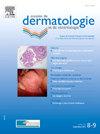Impact of the COVID-19 pandemic on melanoma: A retrospective study from the French clinical database of melanoma patients (RIC-Mel)
IF 2.8
4区 医学
Q2 DERMATOLOGY
引用次数: 0
Abstract
Background
COVID-19 pandemic had a variable impact on the severity of melanomas.
Objective
To assess the role of the COVID-19 pandemic in France on the severity of melanomas at initial diagnosis.
Methods
New melanoma cases recorded in the French RIC-Mel database were included in a retrospective study spanning three timeframes: pre-COVID (01/01/2018 to 03/16/2020), lockdown (03/17/2020 to 10/05/2020), and the COVID pandemic period (hereafter referred to as “COVID”) (11/05/2020 to 30/09/2022). Patient and melanoma characteristics at diagnosis, along with time intervals to lymph node procedures and initiation of systemic treatments, were extracted. Statistical comparisons were conducted between the pre-COVID and COVID periods.
Results
A total of 3650 patients in the pre-COVID period were included: 121 during lockdown, and 2878 during the COVID period. Melanomas diagnosed during the COVID period were thicker (median 1.5 mm; interquartile range [IQR]: 0.7–3.6) compared to those in the pre-COVID period (median 1.2 mm; IQR: 0.5–3.0; p < 0.0001) and more frequently ulcerated (25.4 % vs. 20.6 %; p < 0.0001). The average number of melanomas diagnosed per day decreased from 4.53 (pre-COVID) to 3.30 (COVID), primarily due to reductions in Tis (−32.4 %) and T1 stage diagnoses (−32.5 %).
Adjusted odds ratios (adj OR), accounting for age at diagnosis, sex, personal history of melanoma, and treatment center, indicated increased frequency of advanced tumor stages during the COVID period: T2 (adj OR = 1.23; 95 % confidence interval [CI]: 1.0519–1.459; p = 0.0130), T3 (adj OR = 1.204; 95 % CI: 1.027–1.425; p = 0.0310), and T4 (adj OR = 1.467; 95 % CI: 1.237–1.731; p < 0.001). Stage III cases rose from 6.3 % to 11.9 % (adj OR = 2.05; 95 % CI: 1.67–2.51; p < 0.001). Sentinel lymph node biopsy (SLNB) rates almost doubled (40.3 % vs. 23.4 %; p < 0.001), with a higher positivity rate (adj OR = 1.26; 95 % CI: 1.02–1.56; p = 0.035). Interval times between diagnosis and SLNB, as well as initiation of systemic therapy, remained similar across study periods.
Conclusion
In France, the COVID-19 pandemic was associated with a higher proportion of severe melanoma cases, partially attributed to a reduction in the diagnosis of thin melanomas.
COVID-19大流行对黑色素瘤的影响:来自法国黑色素瘤患者临床数据库(RIC-Mel)的回顾性研究
背景:covid -19大流行对黑色素瘤的严重程度有不同的影响。目的探讨法国新冠肺炎疫情对初诊黑色素瘤严重程度的影响。方法将法国RIC-Mel数据库中记录的新黑色素瘤病例纳入回顾性研究,该研究跨越三个时间段:COVID前(2018年1月1日至2020年3月16日)、封锁期(2020年3月17日至2020年10月5日)和COVID大流行期(以下简称“COVID”)(2020年11月5日至2022年9月30日)。患者和黑色素瘤在诊断时的特征,以及淋巴结手术和开始全身治疗的时间间隔,被提取出来。对新冠前和新冠期间进行统计比较。结果共纳入3650例新冠肺炎前患者,其中封锁期121例,新冠肺炎期2878例。与前COVID时期(中位数为1.2 mm; IQR: 0.5-3.0; p <; 0.0001)相比,在COVID期间诊断的黑色素瘤更厚(中位数为1.5 mm;四分位数间距[IQR]: 0.7-3.6),更频繁地溃疡(25.4 %对20.6 %;p <; 0.0001)。平均每天诊断的黑色素瘤数量从4.53例(pre-COVID)下降到3.30例(COVID),主要是由于Tis(- 32.4 %)和T1期诊断(- 32.5 %)的减少。调整后的优势比(adj或),占诊断、年龄性别、个人历史的黑色素瘤,和治疗中心,表示频率增加先进的肿瘤阶段COVID期间:T2 (adj或 = 1.23;95 %可信区间[CI]: 1.0519 - -1.459; p = 0.0130),T3 (adj或 = 1.204;95 % CI: 1.027 - -1.425; p = 0.0310),和T4 (adj或 = 1.467;95 % CI: 1.237 - -1.731; p & lt; 0.001)。III期病例从6.3 %上升到11.9 % (adj OR = 2.05;95 % CI: 1.67-2.51; p <; 0.001)。前哨淋巴结活检(SLNB)率几乎翻了一番(40.3 % 23.4 vs %;p & lt; 0.001),积极性更高速率(adj或 = 1.26;95 % CI: 1.02 - -1.56; p = 0.035)。诊断和SLNB之间的间隔时间,以及开始全身治疗,在研究期间保持相似。在法国,COVID-19大流行与严重黑色素瘤病例比例较高有关,部分原因是薄黑色素瘤的诊断率下降。
本文章由计算机程序翻译,如有差异,请以英文原文为准。
求助全文
约1分钟内获得全文
求助全文
来源期刊
CiteScore
1.40
自引率
0.00%
发文量
70
审稿时长
81 days
期刊介绍:
Les Annales de dermatologie sont le rendez-vous mensuel incontournable de toute la dermatologie francophone, grâce à leur comité de rédaction qui assure une sélection rigoureuse des articles selon les normes de l''édition scientifique internationale.
Une revue didactique, véritable aide à la pratique médicale quotidienne
Pour compléter et enrichir la partie scientifique, la rubrique Formation médicale continue propose aux lecteurs des textes didactiques et interactifs (Cas pour diagnostic, Notes de pharmacovigilance, la Question du praticien, Dermatologie chirurgicale, la Sélection bibliographique du mois...) qui les font bénéficier d''une formation post-universitaire diversifiée et de qualité. La revue consacre également un espace pour la publication de questions des lecteurs auxquelles des experts apportent une réponse.

 求助内容:
求助内容: 应助结果提醒方式:
应助结果提醒方式:


